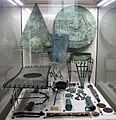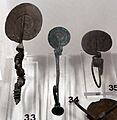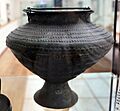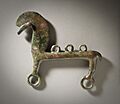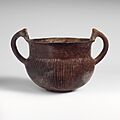Villanovan culture facts for kids
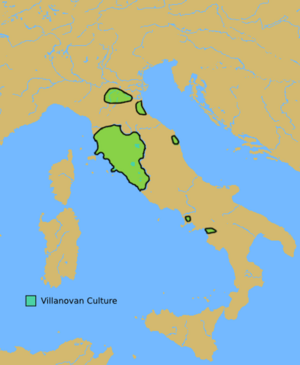 |
|
| Geographical range | Europe (Italy: Emilia-Romagna, Tuscany, Lazio, Campania) |
|---|---|
| Period | Early Iron Age, Early phases of the Etruscan civilization |
| Dates | c. 900–700 BC |
| Preceded by | Proto-Villanovan culture |
| Followed by | Orientalizing period (later 700–500 BC) of the Etruscan civilization |
The Villanovan culture (around 900–700 BC) was an early group of people in Italy. They lived during the Iron Age, a time when people started using iron tools. Many experts believe the Villanovan culture was the very first part of the Etruscan civilization.
These people learned how to work with iron. They also had a special way of burying their dead. They would burn the bodies (called cremation) and then put the ashes into unique pottery jars. These jars had a special double-cone shape.
Contents
History of the Villanovans
The name Villanovan comes from a place called Villanova. This is a small area near Bologna in northern Italy. In the 1850s, a scholar named Giovanni Gozzadini found an ancient cemetery there. This cemetery had many tombs, which helped us learn about these people.
The tombs were like deep pits lined with stones. Inside, they held special jars with ashes. Most of these tombs had not been disturbed, so they gave us a lot of information. Later, another important Villanovan cemetery was found at Verucchio.
The way Villanovans buried their dead is similar to other ancient cultures in Central Europe. These include the Urnfield culture and the Hallstatt culture. The Villanovans put the ashes of their dead into special jars called cinerary urns. These urns were often shaped like the huts where people lived. This was a unique custom of the Villanovan culture.
The urns were made from a type of pottery called impasto. They often had simple patterns scratched onto them, like zigzags and squares. Along with the urns, people were buried with simple items like bronze pins (called fibulae), razors, and rings.
Time Periods of the Villanovan Culture
The Villanovan culture is usually split into two main periods:
- Villanovan I (around 960 BC to 801 BC)
- Villanovan II (around 800 BC to 720 BC)
In the later period (Villanovan II), things started to change a lot. The Villanovans began trading with people from Ancient Greece and other northern areas. This trade brought new items like glass and amber necklaces for women. Men's graves started to include bronze armor and horse equipment.
During this time, some graves became much fancier, showing that some people were becoming more important or wealthy. They also started to bury bodies whole (called inhumation) in special chamber tombs, alongside the older practice of cremation. After Villanovan II, the Etruscan civilization entered a new phase called the Orientalizing period.
Villanovan Timeline within Etruscan History
| Etruscan civilization (900–27 BC) |
Villanovan period (900–720 BC) |
Villanovan I | 900–800 BC |
| Villanovan II | 800–720 BC | ||
| Villanovan III (Bologna area) | 720-680 BC | ||
| Villanovan IV (Bologna area) | 680-540 BC | ||
| Orientalizing period (720–580 BC) |
Early Orientalizing | 720–680 BC | |
| Middle Orientalizing | 680–625 BC | ||
| Late Orientalizing | 625–580 BC | ||
| Archaic period (580–480 BC) |
Archaic | 580–480 BC | |
| Classical period (480–320 BC) |
Classical | 480–320 BC | |
| Hellenistic period (320–27 BC) |
Hellenistic | 320–27 BC |
Metalwork and Trade
The Villanovans were very skilled at working with metal and pottery. The items found in their graves show how good their artisans were. Some graves had even higher quality items, which suggests that some people in the Villanovan society became leaders or important figures.
Tools and other items were often placed in graves. This shows that the Villanovans likely believed in an afterlife. Men's graves often contained weapons and armor. Women's graves usually had tools for weaving cloth. Sometimes, graves had a mix of these items, which might mean that some women used tools or some men made clothes.
During the Villanovan period, the Etruscans traded with other groups around the Mediterranean Sea, like the Greeks. This trade helped them improve their metalworking skills. Greek ideas also influenced Villanovan pottery designs.
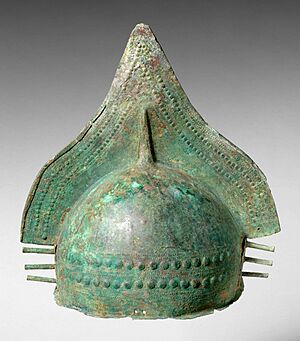
Villanovan Homes
The Villanovans lived in small, rectangular huts. These huts were built using wooden poles and a mix of mud and sticks (called wattle and daub). Inside the huts, archaeologists have found cooking areas, tools, and animal bones. This gives us clues about how families lived.
Some huts had large pottery jars buried in their floors to store food. There were also drains made of rock to collect rainwater and send it to shared water pools.
Villanovan Settlements
Villanovan settlements were mostly found in central Italy. This includes areas like Emilia Romagna (especially Bologna and Verucchio) and Tuscany. Further south, Villanovan burial sites have been found in Campania.
Most Villanovan settlements were small and have left few traces. This is because later Etruscan towns were often built right on top of them. However, their burial sites were usually separate and have survived better. Many historians believe that the Villanovan culture was the direct ancestor of the more famous Etruscan civilization.
Genetics
Scientists have studied the DNA from the remains of a Villanovan woman. She lived around 900-800 BC. Her DNA showed a mix of different ancient European groups. This helps us understand where the Villanovan people came from. It also showed a possible family connection between her and another ancient person found in an Etruscan cemetery.
Images for kids
-
Bronze Harness Trapping in the Shape of a Horse; Villanovan, 9th–8th century BC. LACMA
See also
- Etruscans
- Proto-Villanovan culture
- Urnfield culture
- Prehistoric Italy









